Course main course | Origin Indonesia | |
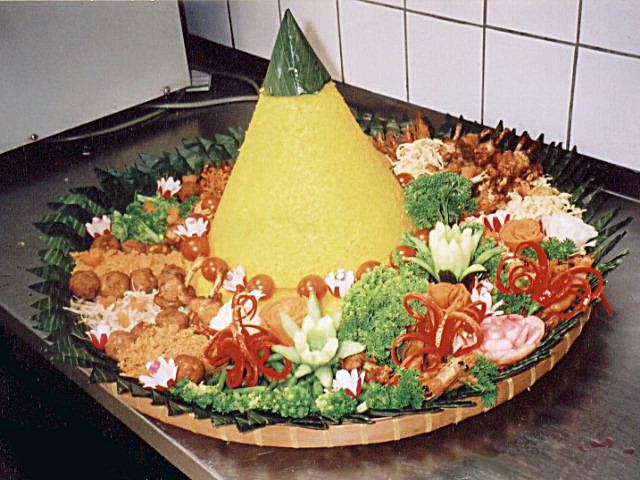 | ||
Serving temperature hot or room temperature Main ingredients Cone shaped rice, urab (vegetables in shredded coconut), fried chicken, fried tempeh, boiled marble egg, shredded omelette, salted anchovy and peanuts Similar Nasi kuning, Urap, Ayam goreng, Kue, Perkedel | ||
Tumpeng is a cone-shaped rice dish like mountain with its side dishes (vegetables and meat). Traditionally featured in the slamatan ceremony, the cone shape of rice is made by using cone-shaped woven bamboo container. The rice itself could be plain steamed rice, uduk rice (cooked with coconut milk), or yellow rice (uduk rice colored with kunyit (turmeric)).
Contents
- Tumpeng ultah 09
- History and tradition
- Surrounding dishes
- Philosophical meaning
- Variations
- Contemporary tradition
- References
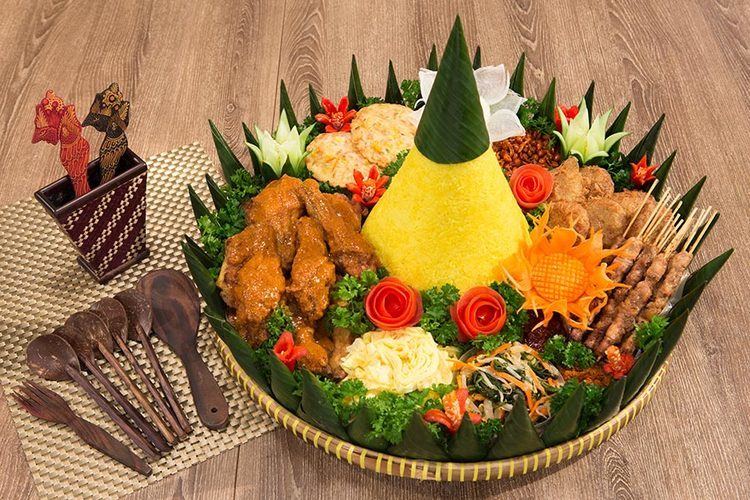
The cone shaped rice erected on tampah (rounded woven bamboo container) covered with banana leaf, and surrounded by assorted of Indonesian dishes. In 2013, Indonesian Ministry of Tourism and Creative Economy promoted tumpeng as one among 30 Indonesian culinary icons, and finally elevate its status as the official national dish of Indonesia in 2014, describe it as "the dish that binds the diversity of Indonesian various culinary traditions."
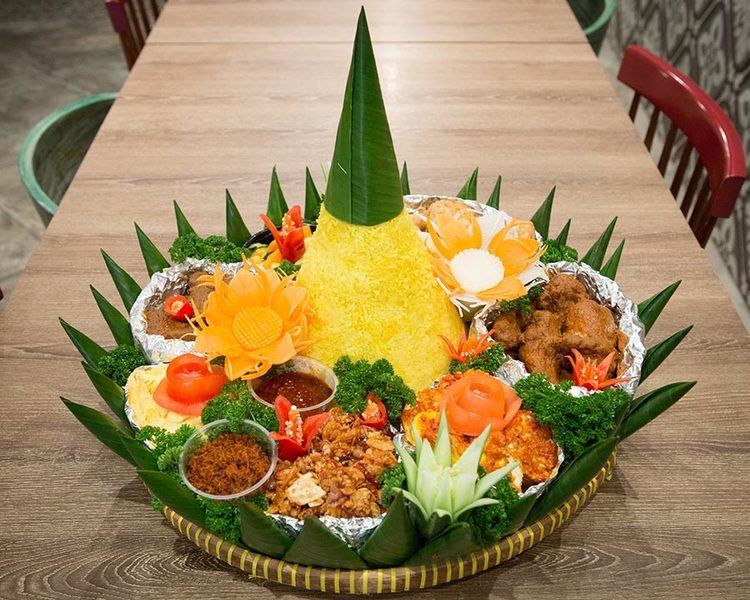
Tumpeng ultah 09
History and tradition

People in Java, Bali and Madura usually make Tumpeng to celebrate important event. However, all Indonesians are familiar with Tumpeng. The philosophy of Tumpeng is related to the geographical condition of Indonesia, especially Java as fertile island with numerous mountains and volcanos. Tumpeng dated back to ancient Indonesian tradition that revered mountains as the abode of hyangs, the spirit of ancestors and gods. The cone-shaped rice meant to mimics the holy mountain. The feast served as somekind of thanks giving for the abundance of harvest or any other blessings.
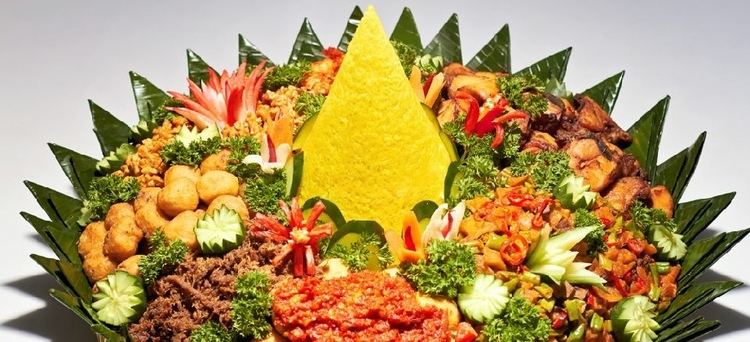
Tumpeng is a symbol of gratitude, in gratitude ceremony (syukuran or slametan), after the people pray, the top of tumpeng is cut and delivered to the most important person. He or she may be the group leader, the oldest person, or the beloved one. Then, all people in the ceremony enjoy the tumpeng together. With tumpeng, people express the gratitude to God and appreciate togetherness and harmony. An annual ceremony involving tumpeng is commonly called 'tumpengan'.
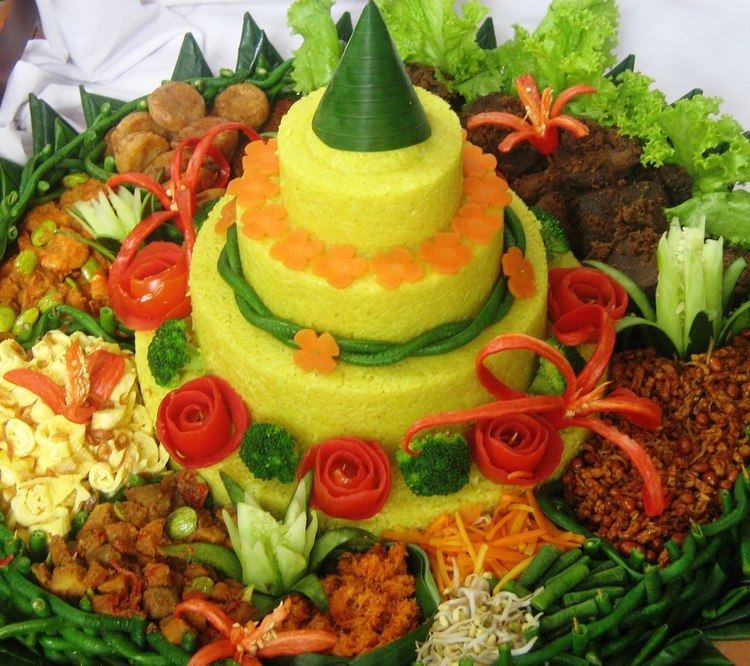
In modern times, the top of the tumpeng is given to an honoured guest in social events, ceremonies or awards. Many Indonesian cities, such as Yogyakarta, a tradition has been developed, the tumpengan ceremony the eve of 17 August, which is Indonesian independence day. The event is meant to pray for safety and welfare of the nation.
Surrounding dishes
The cone shaped rice surrounded by assorted of Indonesian dishes, such as urap vegetables, ayam goreng (fried chicken), ayam bakar (grilled chicken), empal gepuk (sweet and spicy fried beef), abon sapi (beef floss), semur (beef stew in sweet soy sauce), teri kacang (anchovy with peanuts), fried prawn, telur pindang (boiled marble egg), shredded omelette, tempe orek (sweet and dry fried tempeh), perkedel kentang (mashed potato fritters), perkedel jagung (corn fritters), sambal goreng ati (liver in chilli sauce), and many other things.
Traditionally there should be a balance between vegetables, egg, meat and seafood. The composition of a traditional Javanese tumpeng is more complex because the elements must balance one another according to the Javanese belief. Traditional Javanese tumpeng usually involves urap vegetables, tempeh, ayam goreng, teri kacang, fried shrimp, telur pindang, empal gepuk and sambal. After the adoption of tumpeng as Indonesian national dish, tumpeng is expected as a dish that might binds Indonesia's various cooking traditions, and its side dishes might served popular Indonesian dishes, such as gado-gado, satay and rendang. Today the dishes which accompany tumpeng can be of the host discretion, it can be vegetarian, to barbecued seafood.
Philosophical meaning
There is a philosophical meaning on every part of traditional tumpeng. According to folklore in Java and Bali, the cone-shaped tumpeng is a mystic symbol of life and ecosystems and it also symbolizes the glory of God as the Creator of nature, and various side dishes and vegetables represent the life and harmony of the nature. The authentic and complete tumpeng dishes should contain at least one animal meat to represent a land animal, fish to represent sea creatures, an egg to represent winged beast, and vegetables that represent a food stock provided by the plant kingdom. Usually tumpeng is served with spinach as spinach is a traditional symbol of prosperity in Javanese agricultural society.
Here are the philosophical meanings behind some of the ingredients in tumpeng:
Egg: the egg is served with the shell still on. Peeling the egg before eating it symbolizes everything a person has to plan and do before becoming a good person.
Vegetables: A wrap of vegetables represented a good relationship with friends and neighbors. Spinach represented a safe and peaceful life; water spinach represented a person who could live through hardships; string beans represented a long life; and mungbean sprouts represent having ancestors to carry on a legacy.
Catfish: Catfish represented the importance of preparing for troubles in the future. It also represented being humble, since catfish live on the bottom of ponds.
Milkfish: The many bones of the milkfish represented good fortune and prosperity in the future.
Anchovies: Because anchovies live together, the anchovies represented having a good relationship with family and neighbors.
Variations
There are several variants of tumpeng, differentiated according to the ceremonies.
Contemporary tradition
Today, most of Indonesians serving tumpeng as a special dish to celebrate a special occasion; such as a birthday party, arisan, family or neighborhood gathering, farewell party, celebrations, recitals, and many others joyous events. Because of its festivities and celebrative value, up until now tumpeng sometimes used as Indonesian counterpart of birthday cake. Tumpeng contests are sometimes held to commemorate Indonesian Independence day in August 17, or to commemorate women emancipation day, the Kartini day in April 21. The tumpengs in this contest are judged by its decoration and taste.
According to Jati in Local wisdom behind Tumpeng as an icon of Indonesian traditional cuisine, in 2004, the Republic of Indonesia's Ministry of Health rolled out a tumpeng-based food pyramid to encourage healthy eating because tumpeng includes samples of food from every food group. The meat or soy based sides provide iron, zinc, and protein, and the vegetable side dishes provide vitamins and minerals.
In 2009 Garuda Indonesia started offering Mini Nasi Tumpeng Nusantara as part of its new concept to highlight Indonesia's hospitality.
Tumpeng is also offered in various Indonesian restaurants abroad, such as in neighboring Singapore, and the Netherlands.
The building of Suharto's Purna Bhakti Pertiwi Museum in Taman Mini Indonesia Indah Jakarta, took shape of tumpeng.
